Heading out the door? Read this article on the new Outside+ app available now on iOS devices for members! Download the app.
When I think back to my early days of teaching yoga, I used very precise instructions for each asana in my classes. I essentially micro-managed the students, telling them exactly what to do at each moment. I thought I was helping my students.
But by using precise cues, I was ignoring the fact that everyone is unique. What might work well for a couple of students in class won’t necessarily work so well for others. I eventually began to realize that I needed to be open to deviating from a template to make my teaching inclusive to each unique body that was in front of me.
I started to create opportunities for students to explore poses for themselves and build awareness of their bodies on their own terms. I also started to encourage students to focus on what a pose or movement felt like and not so much what it looked like.
One of the poses that I initially approached in an overly precise way was Adho Mukha Svanasana (Downward-Facing Dog Pose). A very recognizable asana, Downward-Facing Dog is a complex pose that combines a partial inversion (in the upper body), a forward fold, and an arm balance. It is a strong way to create a sense of length and space along the spine and our side bodies. The pose strengthens our shoulders, arms, and wrists while stretching the soles of the feet, calf muscles, hamstrings, and gluteus maximus. The asana also has an introspective and grounding quality that allows us to develop our focus and concentration.
But the traditional version of Downward-Facing Dog can be challenging for many of us, particularly if you experience tightness in your hamstrings, calf muscles, or lower back as well or if you have an injury or condition affecting your shoulder, elbow, wrist, or hand. Additionally, the partial inversion is contraindicated for anyone practicing yoga with uncontrolled high blood pressure.
Exploring the following variations on Downward-Facing Dog enables you to experience similar shapes, actions, and benefits as the traditional version while respecting your individual needs.
5 Downward-Facing Dog Pose variations
Preparation
Practicing Marjaryasana (Cat Pose), Bitilasana (Cow Pose), and Plank Pose can help prepare your shoulders and arms for Downward-Facing Dog. Uttanasana (Standing Forward Bend) and Paschimottanasana (Seated Forward Bend) can help prepare your legs and lower back.
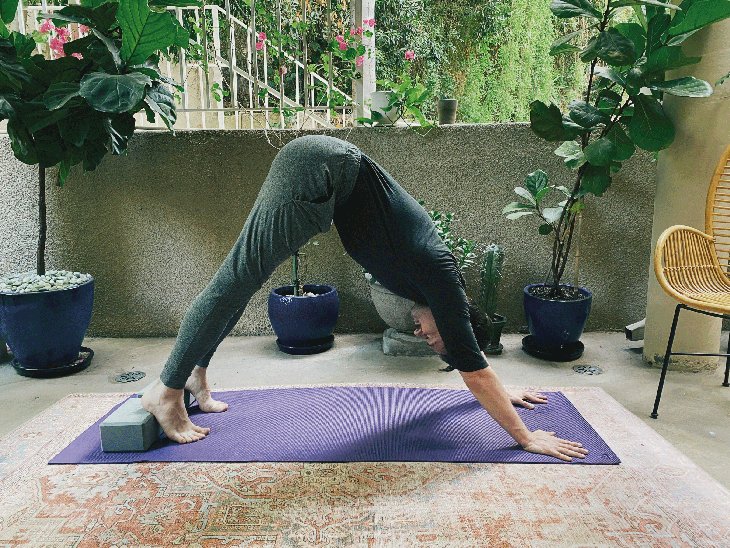
1. Downward-Facing Dog Pose with blocks beneath your heels
This variation can be particularly helpful for anyone with calf tightness who struggles to reach their heels to the mat and therefore may miss out on some of the grounding quality that the pose can offer us.
Begin in Tabletop with your wrists beneath your shoulders and your knees about a foot behind your hips. Place a foam block at its lowest height behind each foot. Tuck your toes, press your hands into the mat, and begin to lift your knees off the mat, reaching your sit bones back and up. Start to straighten your legs until your heels press into the foam blocks.
Start with a gentle bend in your elbows and imagine you are dragging your hands toward each other to engage your arm muscles. Draw your shoulder blades away from your ears and let your neck relax. Focus your gaze toward your navel, at a fixed point on the ground, or between your feet.
Tip
Experiment with placing your hands slightly wider than shoulder-distance apart to see if that helps you feel more stable and comfortable. You also have the option to grasp the edges of your mat for more support.
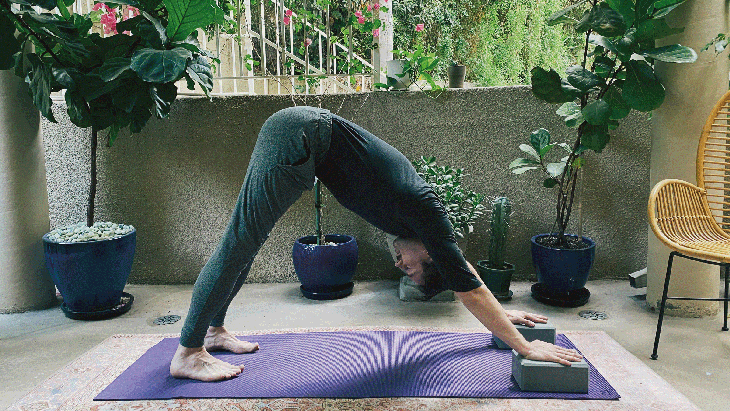
2. Downward-Facing Dog Pose with blocks beneath your hands
This variation shifts your center of gravity back slightly. This reduces the load going through your wrists and shoulders.
Begin in Tabletop and place each hand flat on a foam block. If you find that the blocks slip on your mat you can place them against a wall. Position your wrists slightly in front of your shoulders and your knees about a foot behind your hips. Tuck your toes, press your hands into the mat, and begin to lift your knees off the mat, reaching your sit bones back and up. Start to straighten your legs, reaching your heels toward the back of your mat.
Tip
If your intention for practicing Downward Facing Dog is to create a feeling of length throughout your spine, bend your knees deeply and lift your sitting bones as high as you can. If you would rather focus on stretching the back of your legs, then it’s okay to let your lower back round slightly as you draw your heels toward the floor.
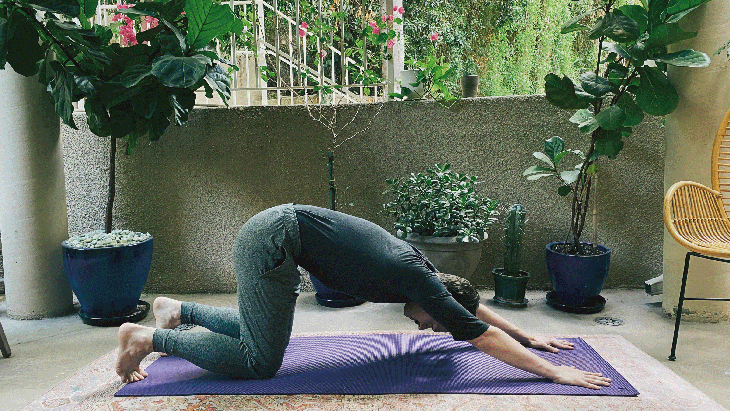
3. Extended Puppy Pose
In this variation on Downward-Facing Dog, you come into an entirely different pose but one that creates a similar shape and stretch in your body. Since your knees are on the floor, less load goes through your wrists and shoulders.
Begin in Tabletop with your wrists beneath your shoulders and your knees beneath your hips. Keep your hips in this position as you walk your hands forward and extend your arms straight ahead until your arms and spine are aligned. Press your hands into the mat, draw your shoulder blades away from your ears, and let your neck relax. Focus your gaze toward your navel or at a fixed point on the ground.
Tip
Find the shoulder position that works best for you. Try gently and externally rotating your upper arms toward the floor so your armpits begin to hollow and turn in toward one another. If this doesn’t feel spacious, begin to internally rotate your shoulders (turning your armpits to face out) until you find a position that feels right.
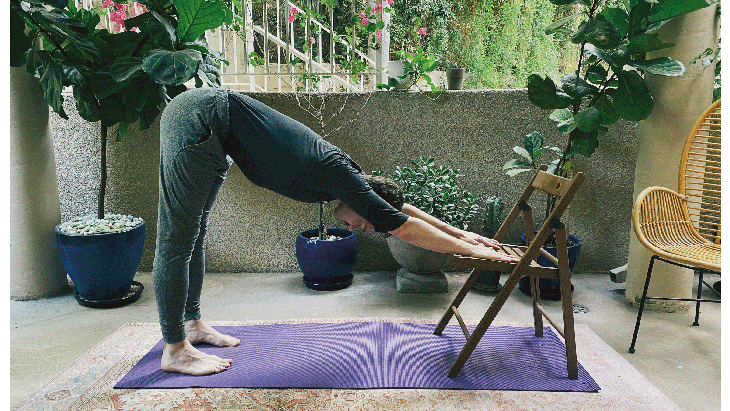
4. Downward-Facing Dog Pose with hands on a chair
This variation is particularly helpful for anyone who struggles to get down onto the floor and back up again, or wants to invert their body less.
Begin standing in Tadasana (Mountain Pose) a couple feet in front of a chair, with the seat facing you. Placing the chair on your mat will prevent any slipping. Place your hands on the back or seat of the chair, depending on how far forward you think you will fold. Start to step your feet away from the chair until your arms are roughly in line with your spine. Press your hands into the chair, draw your shoulder blades away from your ears, and let your neck relax. Focus your gaze toward your navel or at a fixed point on the floor below you.
Tip
You can practice Downward-Facing Dog in a similar way using a wall. Stand three or four feet in front of a wall. Place your hands on the wall at shoulder height and roughly shoulder distance apart. Begin to step your feet further away from the wall until your arms are roughly in line with your spine.
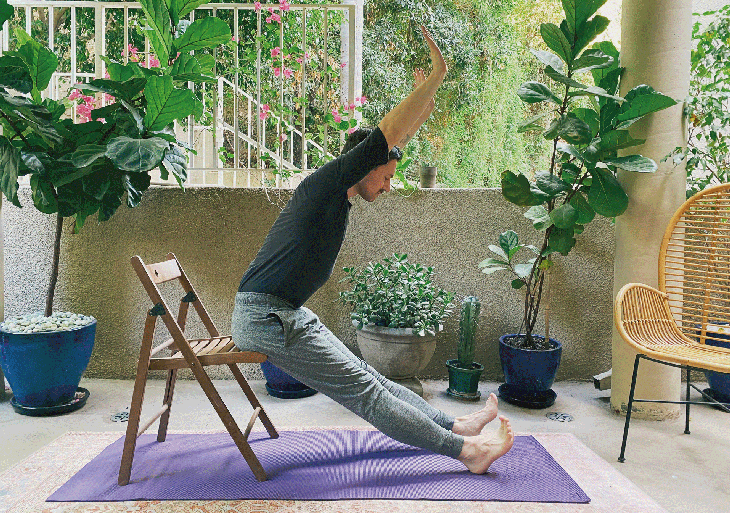
5. Downward-Facing Dog Pose in a chair
This variation is particularly helpful for anyone who struggles to get down onto the floor and back up again, or wants to avoid inversions.
Sit toward the front edge of your chair and extend your legs straight in front of you with your heels resting on the floor. You may also bend your knees and place your feet flat on the floor. Fold forward slightly at your hips and reach your arms straight out in front of your or alongside your ears at a height that feels comfortable. Draw your shoulder blades away from your ears and focus your gaze toward your navel or at a fixed point on the ground between your legs.
About our contributor
Andrew McGonigle has studied anatomy for more than 20 years. After initially studying to become a doctor, he moved away from Western medicine to become a yoga and anatomy teacher. He shares his knowledge of the body and the ways it moves in yoga teacher training courses throughout the world and leads his own Yoga Anatomy Online Course. His second book, The Physiology of Yoga, was published in June 2022. To learn more about Andrew, check out doctor-yogi.com or follow him on Instagram @doctoryogi.
